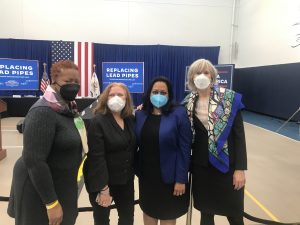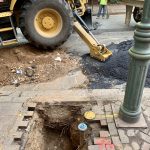New Jersey Future Blog
Crossroads in New Jersey: Investing in Water Infrastructure “Post-Newark”
February 22nd, 2022 by Bailey Lawrence
The completion of Newark’s lead service line replacement program is more than an achievement—it’s an invitation.
In this pandemic era, marked by simultaneous public health and climate crises, it’s easy to become disillusioned with the prospect of change, and even easier to ignore claims that “this is our last chance.” Every year, month, and day seem to be marked by a new record or all-time low—new research that further underscores the severity of the existential threats we face. Thankfully, for several environmental challenges—including lead in drinking water—we already possess the necessary tools and resources for immediate action.
Many have hailed the completion of Newark’s lead service line (LSL) replacement program earlier this month as an epic milestone, and rightfully so. The most populous city in New Jersey achieved the monumental feat of replacing more than 23,000 LSLs in under three years through a combination of local leadership and community participation, both of which were applauded by U.S. Vice President Kamala Harris during her visit to Newark. In an interview with the New York Times, Lead-Free NJ Advocacy Coordinating Committee Co-chair Yvette Jordan similarly commended the City’s community engagement efforts before emphasizing that “this is a first step, not a last step.”
Indeed, the full value of Newark’s LSL replacement program lies not in its completion, but in what it suggests about what can be accomplished in communities across the state. Thus, following the completion of Newark’s nationally acclaimed program, the conversation across the state—and across the country—has pivoted from what happened in Newark to what should happen next.
It’s an issue that has only grown more urgent since the completion of Newark’s program, as more than 180,000 New Jerseyans were notified this week that their water is delivered through a lead pipe. And that’s not all. According to the New Jersey Department of Environmental Protection, more than one million lines across the state remain uncatalogued. In other words, the customers who received notices this week will not be the last.

New Jersey Future Managing Director of Policy and Water Chris Sturm (far right), poses with LFNJ Advocacy Coordinating Committee Co-chair Yvette Jordan; Joan Leary Matthews, Natural Resources Defense Council; and Radhika Fox, US Environmental Protection Agency. Sturm attended Newark’s commemoration of its completed lead service line replacement program earlier this month.
Luckily, although Vice President Harris presented the completion of Newark’s program as evidence of what the Bipartisan Infrastructure Law can help achieve, this isn’t the only source of federal funding at New Jersey’s disposal. New Jersey Future Managing Director of Policy and Water Chris Sturm, who attended the commemoration of Newark’s completed program, points to the State’s share of American Rescue Plan funds as a critical source of investment for New Jersey’s water infrastructure.
“Unfortunately, the Bipartisan Infrastructure Law won’t provide all of the funding we need,” Sturm said. “We estimate that the funding gap for lead pipe replacement in New Jersey remains between $1.5 billion and $2 billion. It is critical that the State provide additional American Rescue Plan funds to help communities eradicate lead in drinking water and other infrastructure challenges. That’s why New Jersey Future is part of the new Clean Water, Healthy Families, Good Jobs campaign, which is seeking a state investment of $1.2 billion for water infrastructure.”
Sturm is joined by several environmental, business, and labor representatives whose organizations are urging the State to make this historic investment, which will simultaneously advance environmental justice, public health, and economic growth.
We all have a stake in clean water, which can only be secured by an investment that matches the considerable cost of inaction. Very few obstacles have such clearly defined solutions, and if the last few years have taught us anything, it’s that we can’t afford to neglect an opportunity to protect our families and neighbors.
Related Posts
Tags: lead in water, lead service line, Newark, water infrastructure
















